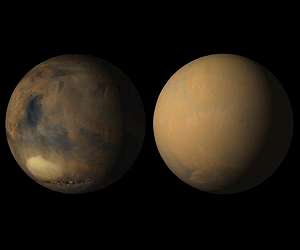The interaction of dust particles in Martian dust storms may cause electric fields that are powerful enough to have charges that induce standing electromagnetic waves known as S?humann resonances. This is the conclusion drawn by physicists from HSE University, the Space Research Institute, and MIPT. The paper was published in Icarus journal.
Mars has been a focus of active study over the last decade, with researchers looking at possible space missions to the planet. Knowledge about the Martian atmosphere increases the chances that such missions will be successful. In particular, the behaviour of dust particles and the plasma-dust system on the surface of Mars should be taken into account in planning space trips.
In 2009, a 34 m radio telescope of NASA’s Deep Space Network registered a non-thermal microwave radiation during a Martian dust storm. In the observed radiation spectrum, attributes of Schumann resonances were detected at frequencies of 7.83 Hz, 14.1 Hz, and 20.3 Hz.
Researchers from HSE University, the Space Research Institute and MIPT looked at the role of dust and dust plasma in the excitement of ultra-low-frequency (below 100 kHz) standing electromagnetic waves on Mars. Since the mid-1950s, this phenomenon has been known as Schumann resonances, after Otto Schumann, an Austrian scholar who was the first to study standing electromagnetic waves in an Earth-ionosphere resonator.
For electromagnetic waves, the Earth and its ionosphere are a huge spherical resonator, with its cavity filled with a weakly electrically conductive medium. If an electromagnetic wave that evolves in this medium goes around the Earth and resonates itself, it can exist for a long time.
Schumann resonances on Earth are presumably caused by thunderstorm charges in the spherical cavity between the planet’s surface and the lower layers of the ionosphere.
The scholars analysed the mechanism that ensures the loading of power in the Schumann resonator. It turned out that electrical discharges are a ‘good candidate’. But these electrical discharges have a different nature as compared to Earthly lightnings. Lightnings in their Earthly understanding are not typical for Martian atmosphere in which dust swirls, also called ‘dust devils’, are widespread. They are small storms measuring about 100 m in diameter that last several minutes. That’s why there are no analogues to Earthly meteorological clouds in the rare and dry Martian atmosphere, but dust phenomena play an important role.
The process of charging the dust particles in the Martian atmosphere has similarities with the processes that take place in volcanic clouds on Earth: two particles consisting of the same material collide, and the smaller one gets a negative charge, while the bigger one charges positive. Under gravity, the heavier positively charged particles gather in the lower parts of dust swirls, while lighter negatively charged particles remain in the upper part. Charges separate, which may lead to electrical discharge.
However, the authors of the paper state that as of yet there is no unambiguous experimental evidence that would confirm the existence of electric discharges in the atmosphere of Mars. Orbital modules that study Mars usually study the upper layers of the atmosphere, while the lower layer remains outside their monitoring zone. To know for sure whether there are Schumann resonances on Mars, the electric fields on the surface of the planet need to be measured.
‘Ideally, we should measure the amplitude of Schumann oscillations and understand whether there is a correlation between changing amplitudes of Schumann resonances and the changes in intensity of dust storms on Mars,’ Sergey Popel said. ‘But to do it, we would need some highly sensitive equipment.’
No such projects have been planned yet, but the second stage of ExoMars mission, which is scheduled for the latter half of 2022, will probably contribute to these studies.
Related Links
HSE University
Mars News and Information at MarsDaily.com
Lunar Dreams and more
|
We need your help. The SpaceDaily news network continues to grow but revenues have never been harder to maintain. With the rise of Ad Blockers, and Facebook – our traditional revenue sources via quality network advertising continues to decline. And unlike so many other news sites, we don’t have a paywall – with those annoying usernames and passwords. Our news coverage takes time and effort to publish 365 days a year. If you find our news sites informative and useful then please consider becoming a regular supporter or for now make a one off contribution. |
||
|
SpaceDaily Contributor $5 Billed Once credit card or paypal |
SpaceDaily Monthly Supporter $5 Billed Monthly paypal only |
|

![]()
Martian global dust storm ended winter early in the south
Milton Keynes UK (SPX) Jul 23, 2021
A dust storm that engulfed the entire Red Planet in 2018 destroyed a vortex of cold air around the Martian south pole and brought an early spring to the hemisphere. By contrast, the storm caused only minor distortions to the polar vortex in the northern hemisphere and no dramatic seasonal changes. Dr Paul Streeter of The Open University’s Faculty of Science, Technology, Engineering and Mathematics will present the work today (23 July) at the virtual National Astronomy Meeting (NAM 2021).
Over two … read more






